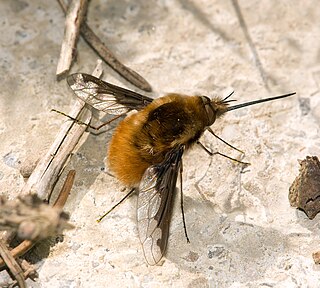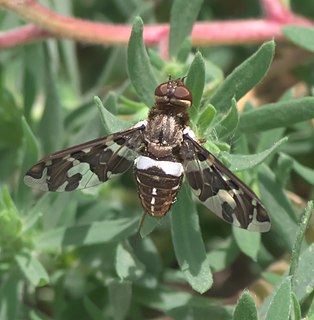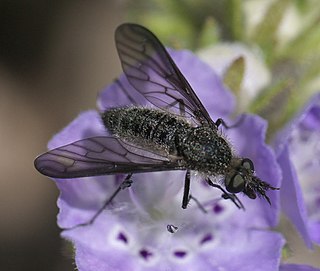
The Bombyliidae are a family of flies, commonly known as bee flies. Adults generally feed on nectar and pollen, some being important pollinators. Larvae are mostly parasitoids of other insects.

The Ulidiidae or picture-winged flies are a large and diverse cosmopolitan family of flies (Diptera), and as in related families, most species are herbivorous or detritivorous. They are often known as picture-winged flies, along with members of other families in the superfamily Tephritoidea that have patterns of bands or spots on the wings. Some species share with the Tephritidae an unusual elongated posteroapical projection of the anal cell in the wing, but can be differentiated by the smoothly curving subcostal vein. Two species, Tetanops myopaeformis and Euxesta stigmatias, are agricultural pests.

Balaana is a genus of flies belonging to the family Bombyliidae (bee-flies). There are about seven described species, including three from western Australia. These are robust and very hairy flies with a body length of 10–18 mm (0.4–0.7 in).

Bombylius canescens, is a species of bee-fly belonging to the family Bombyliidae.

Anthracinae is a subfamily of bee flies in the family Bombyliidae. There are more than 80 genera and 2,000 described species in Anthracinae.

Exoprosopini is a tribe of bee flies in the family Bombyliidae. There are more than 20 genera and 760 described species in Exoprosopini.

Conophorini is a tribe of bee flies in the family Bombyliidae.

Bombyliinae is a subfamily of bee flies in the family Bombyliidae. There are more than 70 genera in Bombyliinae.

Toxophorinae is a subfamily of bee flies in the family Bombyliidae. There are about 7 genera and more than 400 described species in Toxophorinae.

Phthiriinae is a subfamily of bee flies in the family Bombyliidae. There are about 11 genera and more than 120 described species in Phthiriinae.

Brachyanax is a genus of bee fly in the subfamily Anthracinae. It was circumscribed by Neal Evenhuis in 1981. Thirteen species are recognized, and they are found in Asia and Australasia.

Villini is a tribe of bee flies in the family Bombyliidae.
Cythereinae is a subfamily of bee flies in the family Bombyliidae. There are about 19 genera and 150 species in Cythereinae.
Lomatiinae is a subfamily of bee flies in the family Bombyliidae. There are about 16 genera and at least 290 described species in Lomatiinae.
Antoniinae is a subfamily of bee flies in the family Bombyliidae. There are at least 4 genera and 20 described species in Antoniinae.
Crocidiinae is a subfamily of bee flies in the family Bombyliidae. There are about 8 genera and 50 described species in Crocidiinae.
Mariobezziinae is a subfamily of bee flies in the family Bombyliidae. There are about 10 genera and at least 50 described species in Mariobezziinae.
Oniromyia is a genus of bee flies in the family Bombyliidae, the sole genus of the subfamily Oniromyiinae. There are at least two described species in Oniromyia.

Euchariomyia is a monotypic genus of the subfamily Bombyliinae. The only species is Euchariomyia dives.

Lordotinae is a small subfamily of bee flies in the family Bombyliidae. This subfamily was formerly considered a tribe of Bombyliinae, but was elevated to subfamily as a result of research published in 2019.













